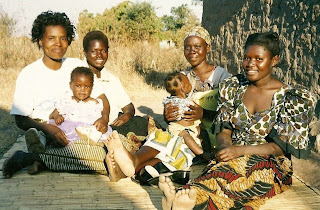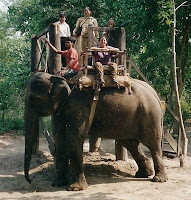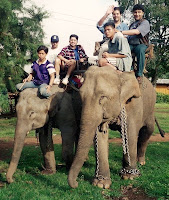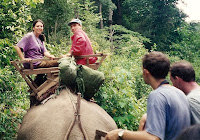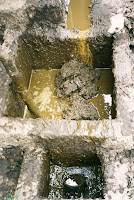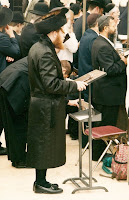After sitting in on 2 small court trials of the Rwanda tribunal in Arusha, Tanzania, I wanted to tour a genocide museum or memorial in Rwanda. In 2003 this was not an easy thing to do. Most Rwandans had tried to put the past (the 1994 genocide) behind them. There were no huge signs saying "Look, the genocide was here!" There were only small reminders in select parts of the country. Even when I asked a couple of people if they could tell by looking at someone if he/she is a Tutsi or Hutu the response was always, "We are Rwandans."
To my surprise there was not anything like a museum or memorial in Kigali. My Lonely Plant guide book mentions 2 locations about 30-60 minutes south of Kigali. I asked the tourist information office in Kigali about this. The woman said there was a big memorial about 20 minutes north of Kigali. I told her I wanted to go. She said I needed to write a letter to some government group or organization. I needed written permission. She made it sound like it really was not an option for me.
Later while I was in Rugengari waiting to view the mountain gorillas, I met a New Zealand couple. We eventually discussed the genocide memorials. They said that they heard of a very big one near Butare, actually in a town about 26 KM west called Ginkorongo. It was not mentioned in the Lonely Planet travel guide but it was mentioned in a Japanese guide book. I thanked them for the information and said I would check it out once I got close to Butare.
Once I got to Butare I met a French woman, who helped me find a place to stay. It turned out that she was a professor. She came to Rwanda to do some research on the genocide. I told her I wanted to see a museum or memorial. She said that she knows a man who knew all the memorials in the country. He was staying in our same guest house. I should knock on his door and ask him. Later that day I ran into him. He gave me specific directions on how to get to the memorial near Gikongoro. The memorial is actually about 2 KM away in a place called Muranbi. I got all the information I needed and decided to head out to Muranbi the very next morning. The French woman warned me that maybe I should not go alone because it is psychologically very difficult. I was imaging Yad Vashem in Jerusalem but with visible bones around the grounds.
I took a minivan to Ginkogoro and began walking to Muranbi. The path was not straight. I stopped to ask directions 4 or 5 times. Eventually I hired a bicycle man to give me a ride the rest of the way. When I got off the bicycle I paid the man, gave him some banana bread, and asked him which direction to the memorial? He pointed forward towards the ghost town/abandon building. I really had no idea what I was going to see. With the help of the bicycle man I finally made it behind the first abandon building. Now I was on my own.
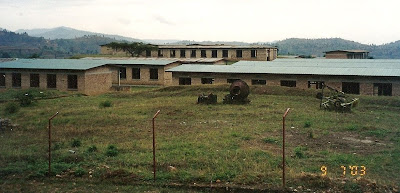 It looked like I was walking into a prison barracks but I was not 100% sure. There were metal bars that went around a bunch of buildings. This must have been where the containing fence was. There was also a big rusted spot light. It must have been used at night to watch for any prisoners trying to escape. I peaked in the first building expecting to find bones. I was trying to mentally prepare myself. I had no idea how I would respond. There was nothing in the room. I imagined it was a barracks with bunk beds and full of Tutsis in 1994. I moved on to the next room. Again, nothing. It was a little creepy being by myself. I started to listen to see if I could hear any ghosts of dead people milling around. Thank G-d--> nothing. I went into another building. It looked like it was where the toilets were. There were spaces for about 4 toilets.
It looked like I was walking into a prison barracks but I was not 100% sure. There were metal bars that went around a bunch of buildings. This must have been where the containing fence was. There was also a big rusted spot light. It must have been used at night to watch for any prisoners trying to escape. I peaked in the first building expecting to find bones. I was trying to mentally prepare myself. I had no idea how I would respond. There was nothing in the room. I imagined it was a barracks with bunk beds and full of Tutsis in 1994. I moved on to the next room. Again, nothing. It was a little creepy being by myself. I started to listen to see if I could hear any ghosts of dead people milling around. Thank G-d--> nothing. I went into another building. It looked like it was where the toilets were. There were spaces for about 4 toilets. Next I found a huge empty hall like a dining room for prisoners. The only thing it had was a dozen hanging ropes full of clothes. They looked like old clothes. I really did not think someone was doing their laundry here but I wasn't sure. When I got closer I could see the clothes had dust and mold on them. These were probably from 1994 but I still was not 100% sure.
Next I found a huge empty hall like a dining room for prisoners. The only thing it had was a dozen hanging ropes full of clothes. They looked like old clothes. I really did not think someone was doing their laundry here but I wasn't sure. When I got closer I could see the clothes had dust and mold on them. These were probably from 1994 but I still was not 100% sure.The next building I went into also had small rooms. For sure I was expecting to see some bones. I crept around the corner. Again, nothing. In one of the doorways there was some writing. It said "Dark room, Cell No. ?" Now I knew for sure I was at a prison. I started wondering where the gas chambers were or where the shooting lines were. There must be graves around somewhere. I went in search of the dead bodies and shooting line. Each building I looked into I saw nothing. I thought there must be something otherwise the French woman would not have said that this place was so psychologically difficult. Empty rooms could not be all. Some of the rooms were locked but that didn't make me suspect anything. Suddenly I heard voices. I turned around to see who was there. Again, it was a little unnerving being there all by myself.
Two men approach me. One puts out his hand to greet me. He has something metal in his left hand that I did not recognize. At first I thought, "Is it a gun? Is it a weapon?" I reach into my pocket to get my Swiss army knife ready. I watched carefully. He must have seen my eyes looking at it. He shook my hand. I recognized the other man as my bicycle man. He must have gotten this man for me. I followed him. He only spoke French. I could not ask any questions. I did determine that yes indeed this was a prison for Tutsis. The man took me to a room I had not seen yet. It was one of the locked rooms. He used the metal piece in his left hand to unlock it.
 Now in front of my eyes were about 30 corpses lying on 4 wooden table like structures. I could see skin stuck to bone. Some skeletons had hair. Some had clothes and some had teeth. I had never seen anything like this before in my life. It was shocking. The most gruesome part was the position of the skeletons.
Now in front of my eyes were about 30 corpses lying on 4 wooden table like structures. I could see skin stuck to bone. Some skeletons had hair. Some had clothes and some had teeth. I had never seen anything like this before in my life. It was shocking. The most gruesome part was the position of the skeletons.
 We went from room to room with the same twisted figures. Some young, some old, some men, and some women. I took several photos. I could see where machetes were taken to some skulls. A child's legs were broken. They were split apart.
We went from room to room with the same twisted figures. Some young, some old, some men, and some women. I took several photos. I could see where machetes were taken to some skulls. A child's legs were broken. They were split apart.
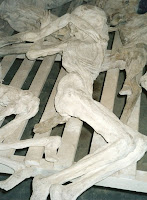 A woman's hands were tied together and she was looking back at them in agony. Several children's heads were knocked against a wall.
A woman's hands were tied together and she was looking back at them in agony. Several children's heads were knocked against a wall.
Room after room I saw the same gruesome images. I held my breath as I entered each room. I decided I should breathe deeply at least once. It was important for me to know what death smells like. I inhaled and almost gagged. The odor was repugnant. I was not sure exactly what I smelled. I know some chemicals must have been used to preserve the skin and bones and teeth, but I did not know what. It did not really matter. It smelled awful and it was appropriate for the scene. After about 10 rooms of dead bodies, I said I had seen enough. The man showed me one more room just of dead children. I looked, I took a picture, and I said finished. I then took one picture of the entire compound, a picture of bones that had been dug up, and one picture of some graves with flowers.
The man showed me one more room just of dead children. I looked, I took a picture, and I said finished. I then took one picture of the entire compound, a picture of bones that had been dug up, and one picture of some graves with flowers.


My tour was over at this point. It was definitely more than I bargained for. I began to walk back towards Ginkorongo. Fortunately for me I met several happy children along the way that helped lift my spirits.

